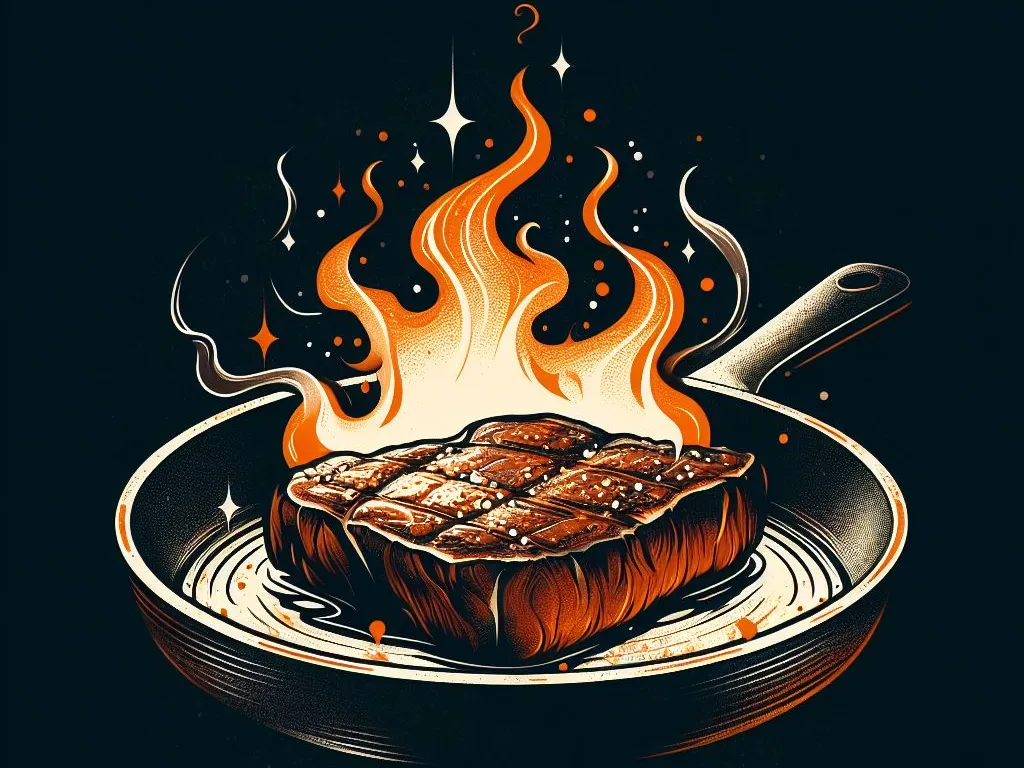Does searing keeps flavors in a culinary haze? Check out all there is to know about the flavorful Maillard daze!

This article is part of series. Check them out all!
Searing, or pan searing, represents a cooking technique employed in grilling, baking, braising, roasting, sautéing, and similar methods. During this process, the surface of the food, often meat like beef, poultry, pork, or seafood, undergoes high-temperature cooking, resulting in the formation of a browned crust.
Browning and blackening, akin techniques, are commonly utilized to sear various pieces of meat, fish, or poultry before finishing the cooking process in the oven. To achieve the desired brown or black crust, the meat surface must surpass 150°C / 300°F. Consequently, searing needs a dry meat surface, as water, which boils at around 100°C / 212°F, would make it impossible.
Searing is a crucial technique in meat preparation for several reasons
- Browning induces desirable flavors through the Maillard reaction.
- The food’s appearance is typically enhanced by a well-browned crust.
- The contrast in taste and texture between the crust and the interior adds interest to the food.
Caramelization, affecting only sugars or simple carbohydrates, is not caused by searing; instead, the Maillard reaction involves reactions between amino acids and certain sugars.
Searing techniques
- Grilling
The food is commonly seared over high heat and subsequently transferred to a lower-temperature section of the grill for completion. - Braising
The seared surface imparts flavor and color to the cooking liquid. - Reverse searing
The conventional cooking sequence is reversed. The item intended for cooking, usually a steak, undergoes cooking at low heat initially until the center attains the desired temperature. Subsequently, the outer layer is subjected to high temperatures to facilitate the Maillard reaction. This method is generally suggested for thicker cuts of meat, measuring 1-1.5″ / 25–38mm or more, ensuring uniform internal cooking temperature while only the external section undergoes searing.
Locking in juices

The widely held belief that the act of searing meat “seals in the juices” has endured and is frequently reiterated. This theory, initially introduced by Liebig around 1850, found favor among contemporary cooks and authors, including Escoffier. It is commonly referenced in relation to larger cuts, particularly steaks and chops, of non-poultry meats like beef, pork, lamb, and tuna.
Experiments designed to assess this theory date back to the 1930s, revealing that seared roasts lost an equivalent or greater amount of moisture. Typically, more liquid is lost because searing exposes the meat to elevated temperatures, leading to the destruction of more cells and, consequently, the release of additional liquid.
A seared piece of meat continues to release moisture in both liquid and vapor forms. As a result, searing is occasionally conducted toward the conclusion of the cooking process to attain the flavor advantages of the Maillard reaction, coupled with the benefits of prolonged cooking for enhanced moisture retention.
Its falseness has been definitively demonstrated on numerous occasions.This holds true across various meats, including pork roasts, steaks, hamburgers, chicken cutlets, and more.
Conversely, flavor enhancement occurs through searing, catalyzing the Maillard browning reactions—a sequence of chemical processes that swiftly occur when proteins and sugars are heated to approximately 300°F / 150°C. This enhances the overall flavor and texture of the dish. However, in nearly all instances, the preferable approach is to sear the food post-roasting, rather than at the start.
Summary
- The browning of meat is caused by the Malliard reaction and not caramelization.
- Searing is achieved through applying direct heat on the surface of food.
- Moisture prevents searing.
- Searing doesn’t lock in juices.